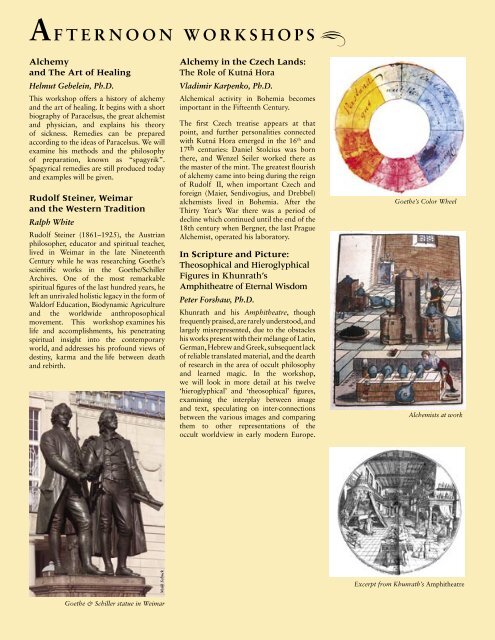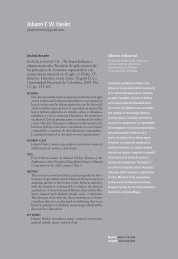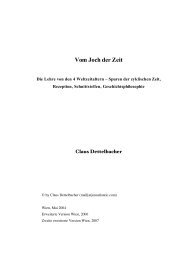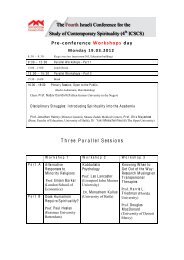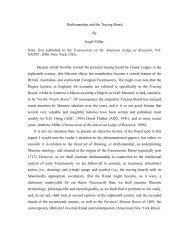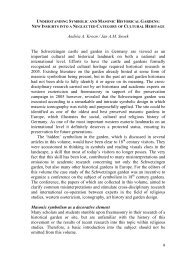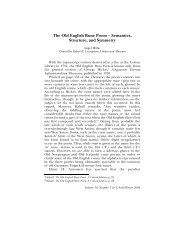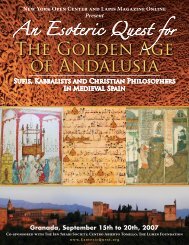An Esoteric Quest in Central Europe, From Renaissance Bohemia to ...
An Esoteric Quest in Central Europe, From Renaissance Bohemia to ...
An Esoteric Quest in Central Europe, From Renaissance Bohemia to ...
You also want an ePaper? Increase the reach of your titles
YUMPU automatically turns print PDFs into web optimized ePapers that Google loves.
A F T E R N O O N W O R K S H O P S<br />
Alchemy<br />
and The Art of Heal<strong>in</strong>g<br />
Helmut Gebele<strong>in</strong>, Ph.D.<br />
This workshop offers a his<strong>to</strong>ry of alchemy<br />
and the art of heal<strong>in</strong>g. It beg<strong>in</strong>s with a short<br />
biography of Paracelsus, the great alchemist<br />
and physician, and expla<strong>in</strong>s his theory<br />
of sickness. Remedies can be prepared<br />
accord<strong>in</strong>g <strong>to</strong> the ideas of Paracelsus. We will<br />
exam<strong>in</strong>e his methods and the philosophy<br />
of preparation, known as “spagyrik”.<br />
Spagyrical remedies are still produced <strong>to</strong>day<br />
and examples will be given.<br />
Rudolf Ste<strong>in</strong>er, Weimar<br />
and the Western Tradition<br />
Ralph White<br />
Rudolf Ste<strong>in</strong>er (1861–1925), the Austrian<br />
philosopher, educa<strong>to</strong>r and spiritual teacher,<br />
lived <strong>in</strong> Weimar <strong>in</strong> the late N<strong>in</strong>eteenth<br />
Century while he was research<strong>in</strong>g Goethe’s<br />
scientific works <strong>in</strong> the Goethe/Schiller<br />
Archives. One of the most remarkable<br />
spiritual figures of the last hundred years, he<br />
left an unrivaled holistic legacy <strong>in</strong> the form of<br />
Waldorf Education, Biodynamic Agriculture<br />
and the worldwide anthroposophical<br />
movement. This workshop exam<strong>in</strong>es his<br />
life and accomplishments, his penetrat<strong>in</strong>g<br />
spiritual <strong>in</strong>sight <strong>in</strong><strong>to</strong> the contemporary<br />
world, and addresses his profound views of<br />
dest<strong>in</strong>y, karma and the life between death<br />
and rebirth.<br />
Maik Schuck<br />
Goethe & Schiller statue <strong>in</strong> Weimar<br />
Alchemy <strong>in</strong> the Czech Lands:<br />
The Role of Kutná Hora<br />
Vladimir Karpenko, Ph.D.<br />
Alchemical activity <strong>in</strong> <strong>Bohemia</strong> becomes<br />
important <strong>in</strong> the Fifteenth Century.<br />
The first Czech treatise appears at that<br />
po<strong>in</strong>t, and further personalities connected<br />
with Kutná Hora emerged <strong>in</strong> the 16 th and<br />
17th centuries: Daniel S<strong>to</strong>lcius was born<br />
there, and Wenzel Seiler worked there as<br />
the master of the m<strong>in</strong>t. The greatest flourish<br />
of alchemy came <strong>in</strong><strong>to</strong> be<strong>in</strong>g dur<strong>in</strong>g the reign<br />
of Rudolf II, when important Czech and<br />
foreign (Maier, Sendivogius, and Drebbel)<br />
alchemists lived <strong>in</strong> <strong>Bohemia</strong>. After the<br />
Thirty Year’s War there was a period of<br />
decl<strong>in</strong>e which cont<strong>in</strong>ued until the end of the<br />
18th century when Bergner, the last Prague<br />
Alchemist, operated his labora<strong>to</strong>ry.<br />
In Scripture and Picture:<br />
Theosophical and Hieroglyphical<br />
Figures <strong>in</strong> Khunrath’s<br />
Amphitheatre of Eternal Wisdom<br />
Peter Forshaw, Ph.D.<br />
Khunrath and his Amphitheatre, though<br />
frequently praised, are rarely unders<strong>to</strong>od, and<br />
largely misrepresented, due <strong>to</strong> the obstacles<br />
his works present with their mélange of Lat<strong>in</strong>,<br />
German, Hebrew and Greek, subsequent lack<br />
of reliable translated material, and the dearth<br />
of research <strong>in</strong> the area of occult philosophy<br />
and learned magic. In the workshop,<br />
we will look <strong>in</strong> more detail at his twelve<br />
‘hieroglyphical’ and ‘theosophical’ figures,<br />
exam<strong>in</strong><strong>in</strong>g the <strong>in</strong>terplay between image<br />
and text, speculat<strong>in</strong>g on <strong>in</strong>ter-connections<br />
between the various images and compar<strong>in</strong>g<br />
them <strong>to</strong> other representations of the<br />
occult worldview <strong>in</strong> early modern <strong>Europe</strong>.<br />
Goethe’s Color Wheel<br />
Alchemists at work<br />
Excerpt from Khunrath’s Amphitheatre


